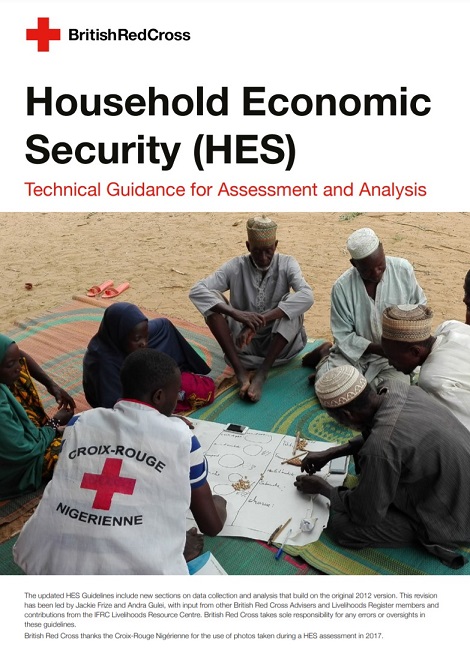Household Economic Security (HES). Technical Guidance for Assessment and Analysis, 2020 edition. - Livelihoods Centre
Asset Publisher
This guidance describes the HES 4 Step Assessment and Analysis Process used to identify household level economic security. Users are guided through the assessment data collection and analysis steps in a series of sub-steps that determine household level food security, basic needs and livelihood needs as well as risks. The methodology can be used in both development and crises contexts.
HES assessments generate considerable information about household and wider community resources, assets and capacities and is therefore a useful tool to feed into integrated programme response analysis and design. By identifying socio-economic groups based on their food and income sources and capacity to withstand livelihood related contextual risks, HES findings are a useful tool for selecting and identifying vulnerable groups for inclusion into a variety of programmes.
The Components of Household Economic Security

A number of analytical themes and questions that drive the HES methodology are presented to help users understand if using the HES methodology will be useful for feeding into decision-making processes involving strategy development and operational programming in a given context, based on an analysis of the following 7 themes:

The guidance and tools can be downloaded:
HES Guidelines
HES visual
Tools
- 1 - KII with Institutions and Authorities (Guide)
- 2 - KII with community leader (Template)
- 3 - FGD with socio-economic goups (Guide)
- 4 - Household survey (Questionnaire)
- 5 - KII for seasonal calendar and food production (Guide)
- 6 - FGD with mothers (Guide)
- 7 - KII with additional actors in the community (Guide)
- 8 - Food Basket price monitoring (Template)
- 9 - KII for Cereal market retailers and wholesalers (Guide)
- 10 - KII for Cash crop market retailers and wholesalers (Guide)
- 11 - KII for Livestock market (Guide)
- 12 - Community observation (Guide)
HES Key Terminology
HES Reports
- 2022 Urban HES Bangladesh - EN + Urban HES Bangladesh Annexes - EN
- 2018 HES Nepal - EN
- 2017 HES Niger - FR
- 2016 HES Panama - ES
- 2013 HES Namibia - EN
Additional Tools
- Household survey to assess impact of Covid-19 on FSL - (LRC)
- Key informants interview template to assess impact of Covid-19 on FSL - (LRC)
- Focus Group Discussion template to assess impact of Covid-19 on FSL - (LRC)
This guidance is suitable for all Red Cross Red Crescent (RCRC) staff, volunteers and technical practitioners who wish to conduct livelihood assessment and analysis to feed into programme and strategy related decisions. Ideally, users should have some technical expertise in food security/livelihoods and in project cycle related areas of needs assessment, response analysis, report writing and programme design.
This technical guidance does not include programme design; for design, monitoring and evaluation purposes. Existing resources for this can be found in the Livelihoods Resource Centre Toolbox. To support the use of the HES methodology and RCRC capacity building, the IFRC Livelihoods Resource Centre developed the Emergency and Recovery Livelihoods Assessment (ERLA) training that prepares participants to conduct economic security needs assessments following a disaster.
The HES approach was originally developed to support specific assessments after the impact of a sudden onset disaster or crisis. To maintain that essential aspect of the RCRC disaster response work, each section in the guidelines includes some pointers of what to look for when you are carrying out a HES assessment in response to a crisis or disaster.
. Technical Guidance for Assessment and Analysis, 2020 edition. title=Household Economic Security (HES). Technical Guidance for Assessment and Analysis, 2020 edition.)
- Organization: British Red Cross
- Pages: 88
- Year of publication: 2021
- Copyright: British Red Cross


